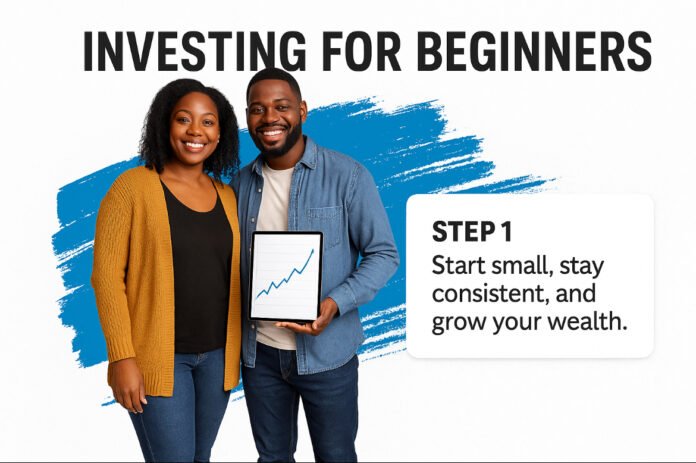Introduction: Investing for Beginners
If you’ve ever felt confused or overwhelmed by the world of investing, you’re not alone. For most people, especially those new to personal finance, diving into the investing world can feel like learning a whole new language. But here’s the good news: investing for beginners doesn’t have to be intimidating.
In fact, the earlier you begin, the more time you give your money to grow. That’s because of a powerful force called compound interest; the ability of your investments to earn returns, which then also earn returns over time. Even modest investments made early on can snowball into significant wealth if left untouched and consistently contributed to.
However, the financial industry can sometimes make investing sound more complicated than it really is. You might think you need a lot of money, a financial advisor, or a deep understanding of stocks and market trends to get started. But the truth is, you can begin with as little as a few dollars and a solid grasp of the fundamentals.
This article is your comprehensive guide to investing for beginners. We’ll walk through 7 essential steps that will help you build a strong financial foundation, understand your investment options, and grow your wealth steadily and confidently. These steps are designed to give you not just information, but a roadmap for taking action, whether you’re starting at 18 or 48.
You’ll learn how to set clear financial goals, why building an emergency fund is critical before investing. It is important to know the basics of stocks, bonds, index funds, and how to pick the right investment accounts. We’ll also explain how to start with small, to make consistent contributions, why diversification matters, and how to stay the course even when markets get rocky.
If you’re ready to take control of your financial future and start building long-term wealth, this step-by-step guide to investing for beginners will show you how to get started the smart way, today.
Let’s dive in.
Step 1: Investing for Beginners: Set Clear Goals
One of the most important steps in investing for beginners is setting clear financial goals. Without goals, investing can feel like shooting arrows in the dark; you might hit something, but it won’t necessarily be what you wanted. Goals give your investment plan direction, clarity, and purpose.
Start by thinking about what you’re investing for. Are you hoping to buy a house in five years, save for your children’s education, or retire comfortably in 30 years? Each of these goals requires a different investment strategy, level of risk, and time horizon. Short-term goals (like saving for a wedding or vacation within three years) often require safer, more liquid options, while long-term goals (like retirement) allow you to take on more risk because you have decades to ride out market ups and downs.
A powerful framework for setting investing goals is SMART — Specific, Measurable, Achievable, Relevant, and Time-bound. Instead of a vague goal like “I want to be rich,” make it specific: “I want to save $50,000 in 10 years for a down payment on a home.” That way, you can calculate how much you need to invest monthly, what kind of returns you’ll need, and whether your goal is realistic given your budget.
Here’s an example: Imagine Sarah, a 25-year-old who wants to retire at 65 with $1 million. Using a compound interest calculator, she discovers that if she invests $300 per month in a stock index fund averaging 7% annual returns, she can reach that goal. By setting a clear, measurable target, Sarah now has a roadmap to follow instead of guessing.
For investing for beginners, setting goals also helps reduce anxiety. When you know why you’re investing, you’re less likely to panic during market downturns. For example, if your goal is retirement 30 years away, you won’t worry as much about short-term dips. Your long-term vision keeps you focused and disciplined.
Another key point is to prioritize your goals. You might want to travel the world, buy a house, and retire early, but you can’t fund everything at once. Start with the essentials, like building an emergency fund and contributing to retirement. Once those are stable, add secondary goals like vacations or luxury purchases.
Ultimately, investing for beginners is about creating a personal financial roadmap. Clear goals keep you motivated, help you choose the right investments, and give you a reason to stay consistent over time.
Step 2: Investing for Beginners: Build an Emergency Fund
Before diving headfirst into stocks, bonds, or retirement accounts, one of the most crucial steps for investing for beginners is building a solid emergency fund. Think of this as your financial safety net. The cushion that keeps you from derailing your investment journey when unexpected expenses pop up.
Life is unpredictable. A sudden car repair, medical bill, or job loss can strike when you least expect it. Without an emergency fund, many people are forced to dip into their investments, rack up high-interest credit card debt, or even take out risky loans just to cover expenses. This not only adds financial stress but also undermines your progress toward long-term wealth building.
So, how much should you save? A common rule of thumb is to have three to six months’ worth of living expenses in your emergency fund. For example, if your essential monthly costs (rent, food, utilities, transportation) total $2,000, your fund should ideally range from $6,000 to $12,000. If you have a stable job and minimal dependents, you may be fine on the lower end. But if you’re self-employed, supporting a family, or working in a volatile industry, aim for the higher end.
Equally important is where you keep this fund. Since emergencies can happen anytime, the money needs to be liquid and accessible. A high-yield savings account, money market account, or short-term certificate of deposit (CD) are all good options. Avoid putting your emergency fund in stocks or long-term investments, because you don’t want to risk losing money right when you need it most.
Here’s an example: Imagine James, a beginner investor who started putting $300 a month into stocks, but ignored his emergency savings. Six months later, he faced an unexpected $2,000 medical bill. Because he had no cushion, he was forced to sell some of his stocks at a loss to cover the expense. If James had built an emergency fund first, he could have kept his investments intact and avoided unnecessary losses.
For investing for beginners, this step may feel slow compared to the excitement of buying stocks or crypto, but it’s one of the smartest moves you can make. An emergency fund gives you peace of mind, protects your investments, and ensures that you won’t be thrown off course by life’s curveballs.
By building this safety net early, you’re setting yourself up for success. Once your emergency fund is in place, you’ll have the confidence to invest consistently without worrying about pulling money out during tough times. In other words, it’s the foundation that allows your long-term wealth plan to thrive.
Step 3: Investing for Beginners: Understand Your Risk Tolerance
One of the most overlooked, yet essential parts of investing for beginners is understanding your risk tolerance. Simply put, risk tolerance is how comfortable you are with the ups and downs of the market and how much volatility you can handle without panicking or abandoning your strategy.
Every investment carries some level of risk. Stocks can soar in value one month and dip the next. Bonds may feel safer but often deliver lower returns. Real estate can be profitable but also illiquid. As a beginner, it’s easy to get caught up in the excitement of potential gains while forgetting that losses are part of the process too. That’s why knowing your risk tolerance before committing your money is so important.
Your risk tolerance depends on three main factors:
A practical way to evaluate risk tolerance is to look at asset allocation. For investing for beginners, a balanced mix often includes a combination of stocks, bonds, and cash. For example, a younger investor might go with 80% stocks and 20% bonds, while someone closer to retirement might prefer 40% stocks and 60% bonds. The goal is to strike a balance between growth potential and financial security.
Here’s a scenario: Maria, age 25, started investing aggressively in growth stocks. When the market dipped, her portfolio lost 15% in just two months. She panicked, sold her investments at a loss, and swore off the market. Maria’s mistake wasn’t investing, it was not aligning her investments with her risk tolerance. If she had chosen a diversified approach with some safer assets, she would have been less anxious and more likely to stay invested.
For investing for beginners, the takeaway is simple: your strategy should match your comfort level and long-term goals. Understanding your risk tolerance doesn’t mean avoiding risk altogether, it means taking risks you can handle without losing confidence. The more you know yourself, the more disciplined and successful you’ll be on your investing journey.
Step 4: Investing for Beginners: Diversify Your Portfolio
When it comes to investing for beginners, one of the smartest rules you can follow is: don’t put all your eggs in one basket. This simple phrase captures the essence of diversification. Spreading your money across different types of investments so that one setback doesn’t ruin your entire financial plan.
Diversification helps manage risk while giving you exposure to multiple opportunities for growth. Imagine investing all your savings in a single company. If that company struggles or goes bankrupt, your entire portfolio could collapse. But if your money is spread across dozens of companies, industries, and even asset classes, the impact of one poor performer is much smaller.
Personal Finance Basics: Why Diversification Matters
Markets are unpredictable. Stocks can deliver impressive returns but are often volatile. Bonds tend to be more stable, but usually offer lower growth. Real estate may appreciate steadily but lacks liquidity. By combining different asset classes, you can balance growth potential with safety, creating a portfolio that can weather both booms and downturns.
For investing for beginners, this balance is critical. Many new investors make the mistake of chasing “hot” stocks or putting everything into one trend, only to face heavy losses when the market shifts. Diversification minimizes that risk by ensuring your portfolio isn’t overly dependent on a single source.
Types of Diversification
There are several ways to diversify:
Personal Finance Basics: A Beginner-Friendly Approach
If you’re just starting out, one of the easiest ways to diversify is by using a total market index fund or ETF. These funds allow you to own small slices of thousands of companies at once, giving you broad exposure without having to research and buy each stock individually. Pairing this with a bond index fund provides stability and smoother returns.
Here’s an example: Alex, a beginner investor, started with $5,000. Instead of buying just a few individual stocks, he split his portfolio into 60% stock index funds, 30% bond funds, and 10% cash savings. Over time, when one part of his portfolio dipped, another part often held steady or even grew protecting him from major losses.
The Long-Term Benefit
Diversification doesn’t guarantee profits, but it does reduce the likelihood of devastating losses. It’s like building a safety net under your financial journey. For investing for beginners, this strategy builds confidence by smoothing out the roller coaster of market fluctuations.
The key is not perfection, but balance. A well-diversified portfolio allows you to grow your wealth while protecting yourself from unnecessary risk. A vital lesson for every beginner investor.
Step 5: Investing for Beginners: Start Small and Stay Consistent
One of the biggest misconceptions about investing is that you need a large amount of money to begin. In reality, the most successful investors often started with very little. For investing for beginners, the key isn’t the size of your first investment, it’s the consistency with which you keep adding over time.
Why Starting Small Works
Many beginners delay investing because they think they need thousands of dollars before it makes sense. The truth is that waiting often costs more than starting small. Thanks to compound interest, even small contributions grow significantly when given enough time. For example, investing just $100 a month at a 7% average return can grow to over $120,000 in 30 years. That’s the power of consistency.
Starting small also removes the pressure. Instead of worrying about making a perfect choice with a large sum, you can learn gradually, adjust your strategy, and build confidence without risking too much in the beginning.
Personal Finance Basics: The Role of Consistency
Consistency is where most beginners succeed or fail. Market ups and downs are inevitable, but sticking with a regular investing habit creates stability. This approach is known as dollar-cost averaging (DCA). Investing a fixed amount of money at regular intervals regardless of market conditions.
With DCA, sometimes you’ll buy shares when prices are high, and sometimes when they’re low. Over time, the average cost of your investments balances out. This reduces the risk of investing a lump sum at the wrong time and helps smooth out volatility. For investing for beginners, dollar-cost averaging is one of the easiest and most effective strategies to follow.
Practical Example
Consider Mia, who wanted to begin investing but only had $50 a month to spare. Instead of waiting until she had a larger lump sum, she set up an automatic transfer into a low-cost index fund. After a year, she had contributed $600, but thanks to market growth, her account had grown to $640. More importantly, she had developed a saving and investing habit that could easily scale up as her income increased.
Tools That Make It Easy
Today, there are countless apps and brokerages that allow you to start investing with as little as $5. Many also let you purchase fractional shares, meaning you don’t need to buy a full share of a company like Amazon or Apple, you can own just a portion. This accessibility makes investing more approachable than ever before.
The Long-Term Mindset
Consistency also teaches patience. Investing for beginners isn’t about getting rich quickly, it’s about setting the foundation for wealth that grows steadily over years and decades. By starting small, you remove excuses. By staying consistent, you create unstoppable momentum.
The combination of these two habits; small beginnings and consistent action is what transforms investing from an intimidating challenge into a natural, sustainable part of your financial journey.
Step 6: Investing for Beginners: Understand Risk and Stay Educated
Every investment carries some level of risk whether it’s stocks, bonds, real estate, or even keeping your money in cash. For investing for beginners, the goal is not to eliminate risk but to understand it, manage it, and stay educated so that your choices align with your financial goals.
The Nature of Risk
Risk in investing generally means the possibility of losing money or not achieving the expected return. For example:
The key for beginners is to recognize that no investment is completely risk-free. Even not investing has a risk. The risk of inflation eroding your savings.
Risk vs. Reward
A basic principle in investing is that higher potential returns usually come with higher risk. For instance, investing in a startup company could bring massive gains if the business succeeds, but it could also result in a total loss if it fails. On the other hand, investing in a government bond offers lower returns but carries very little risk of default.
For investing for beginners, finding a balance between risk and reward is crucial. Too much risk could lead to panic selling when markets drop, while too little risk may not grow your money fast enough to meet long-term goals.
Personal Finance Basics: How to Manage Risk
The Role of Education
One of the most powerful tools for reducing investment anxiety is knowledge. Thanks to podcasts, YouTube channels, online courses, and beginner-friendly books, financial literacy is more accessible than ever. Staying updated allows you to adapt your strategies as markets change and avoid falling for common mistakes or scams.
A Healthy Perspective on Risk
It’s normal to feel nervous when you see your portfolio drop in value during a market downturn. But remember: downturns are part of the investing cycle. Historically, markets have always recovered, and those who stay consistent often see the greatest rewards.
Understanding risk doesn’t mean avoiding it, it means respecting it. For investing for beginners, learning how to balance your comfort level with long-term goals is the key to financial growth.
Step 7: Investing for Beginners: Stay Patient and Think Long-Term
One of the hardest lessons for investing for beginners is patience. In today’s fast-paced world, we are used to instant results, quick deliveries, viral trends, and same-day service. But investing doesn’t work like that. The real power of building wealth comes from time in the market, not timing the market.
Personal Finance Basics Why Patience Matters
When you start investing, you’ll notice market ups and downs. Stocks rise one week and may fall the next. If you react emotionally, selling when prices dip or chasing after the latest “hot” stock, you risk losing money. History shows that those who stay invested through both highs and lows generally come out ahead.
For example, the S&P 500 has gone through crashes, recessions, and global crises, yet over the long run, it has continued to grow. If you had invested $1,000 in the S&P 500 twenty years ago and simply left it alone, you’d have far more today even with all the ups and downs. That’s the power of long-term patience.
Compounding Rewards
Another reason patience is key is the power of compound interest. The longer your money stays invested, the more it multiplies. For beginners, this means that even small, regular contributions can grow into significant wealth over decades.
For instance:
Avoid the Short-Term Mindset
Investing for beginners often comes with the temptation to check your portfolio daily or follow financial headlines obsessively. But short-term news is often noisy and misleading. Instead of reacting to every market swing, focus on your bigger financial picture: your goals, timeline, and strategy.
Staying Consistent
Patience doesn’t mean doing nothing. It means sticking to your plan consistently. Keep contributing to your investments regularly, even when markets dip. In fact, downturns can be an opportunity. Buying when prices are low positions you for greater growth when the market rebounds.
The Long-Term Mindset
Think of investing like planting a tree. You don’t dig it up every week to see if it’s growing. You water it, give it sunlight, and let time do the work. The same principle applies to wealth building. The earlier you plant the seed and the longer you let it grow, the stronger and bigger it will become.
Final Note on Patience
For investing for beginners, learning to trust the process is one of the greatest skills you can develop. Markets will rise and fall, but wealth grows for those who stay committed, avoid panic, and think long-term.
Final Thoughts: Investing for Beginners: Your Financial Future Starts Now
If you’ve made it this far, congratulations; you’re already ahead of the curve. For most people, the idea of investing brings up anxiety, confusion, or hesitation. But as you’ve seen throughout this guide, investing for beginners doesn’t have to be overwhelming. In fact, it’s often the simplest, most consistent strategies that yield the greatest results over time.
What’s most important is taking that first step. Whether you start with $50 or $5,000, what matters is that you’re moving forward. The earlier you begin investing, the more time you give your money to grow through the power of compound interest. And as a beginner, you have a unique advantage, you’re not tied to past mistakes or bad financial habits. You can build your wealth from a place of awareness, education, and intentionality.
We live in a time where financial literacy is more accessible than ever before. Countless apps, podcasts, books, and courses are tailored specifically for investing for beginners. Use them. Engage with content that builds your confidence and helps you make smarter decisions. Your investment journey doesn’t stop after reading one article, this is just the launchpad for a lifelong process of growth.
Remember, investing isn’t about making quick money. It’s about long-term stability, freedom, and peace of mind. It’s about reaching a point where your money works for you, not the other way around. As a beginner, your focus should be on learning the fundamentals, making informed choices, and sticking to a consistent plan, even when the market fluctuates.
It’s also worth acknowledging that your path won’t be perfect. You may make small mistakes, second-guess your decisions, or get nervous during market downturns. That’s normal. The key is to stay committed to your goals, continue learning, and keep your eyes on the big picture. Successful investors aren’t the ones who always pick the perfect stock, they’re the ones who stay the course, adjust when needed, and play the long game.
If you ever feel uncertain, go back to the basics. Revisit the 7 steps outlined in this article. Are your goals clear? Is your emergency fund solid? Are you diversified? Are you investing regularly? These questions will guide you back to a stable path anytime you feel lost.
To sum it up: investing for beginners is not about being perfect, it’s about being consistent, informed, and intentional. Your financial future is not built overnight, but every decision you make today is a brick in the foundation of long-term wealth. Don’t wait for the “perfect” moment. That moment is now.
Take control. Start small. Learn constantly. And above all, believe in your ability to grow your wealth.
Your future self will thank you
Ready to Start Your Investing Journey?
Don’t just read about wealth—start building it today. Whether you’re saving for retirement, planning for financial freedom, or simply learning how to grow your money, these 7 steps are only the beginning.
👉 Next Steps:
- Explore our guide on Understanding Risk in Investments
- Read How to Start Investing with Little Money
Start small, stay consistent, and watch your money grow. Your journey to financial independence begins now.








